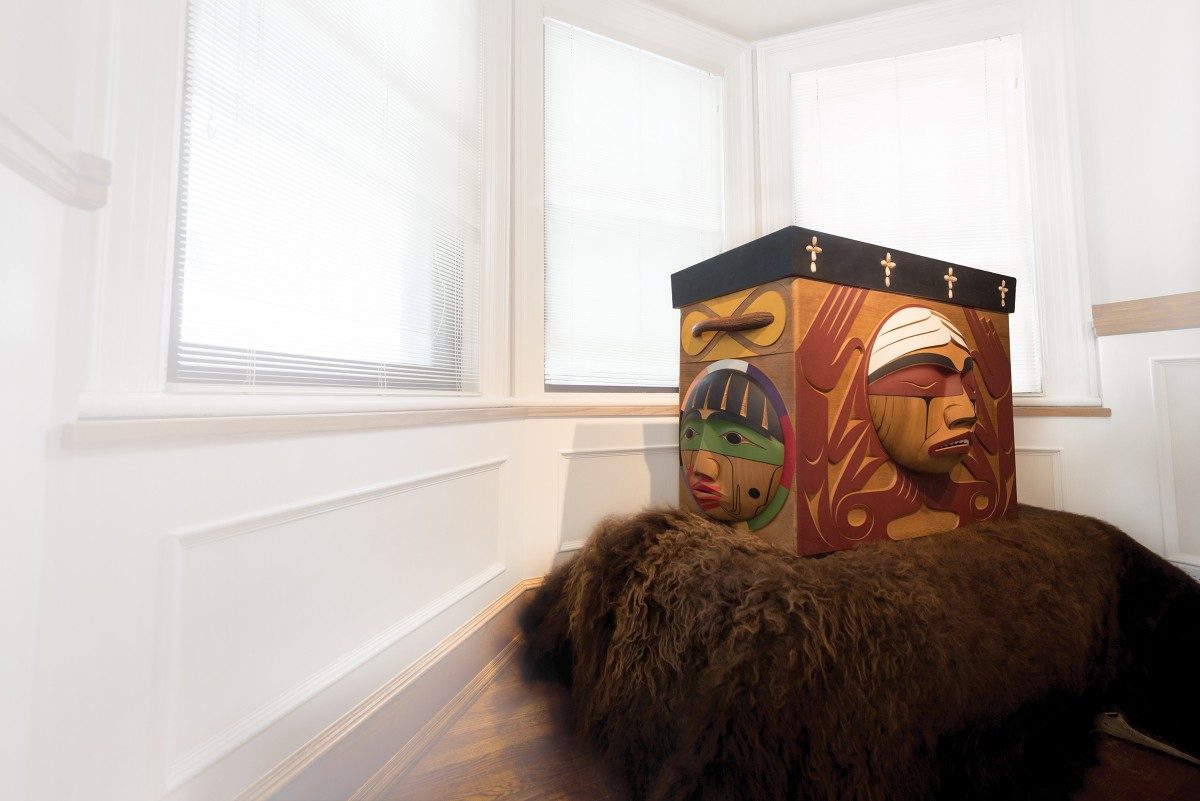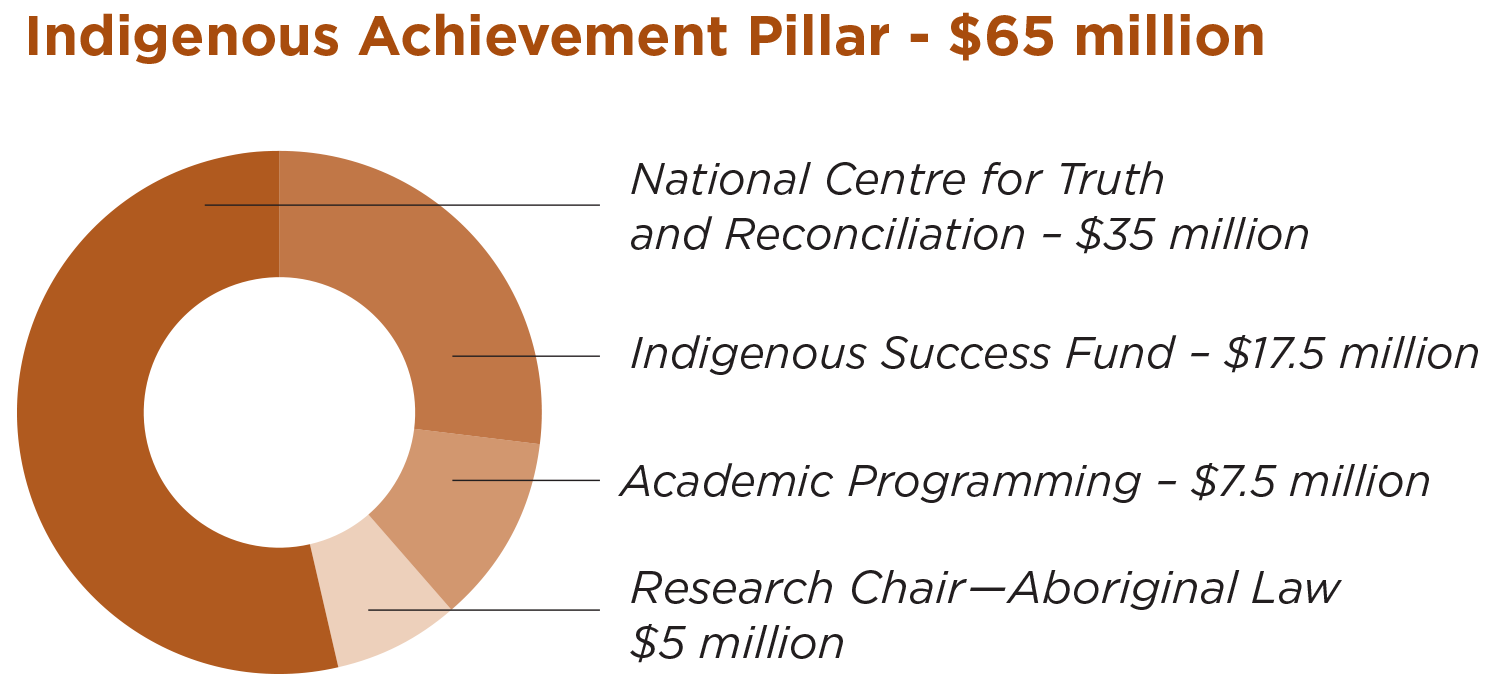
Creating a Path Forward in Indigenous Achievement
Spring 2017
The Bentwood Box sits in a sunny alcove overlooking the Red River and easily commands the attention of the room, as it has done throughout the emotional journey that brought it here.
Crafted from a single piece of western red cedar, with carvings on each side in honour of First Nations, Métis and Inuit peoples, the box now calls the National Centre for Truth and Reconciliation (NCTR) on the University of Manitoba’s Fort Garry campus home.
The box is a keeper of truths, and embodies the strength—and the pain—of the Indigenous cultures it represents.
In 2009, the Truth and Reconciliation Commission (TRC) commissioned Coast Salish artist Luke Marston to create a piece of art to represent all the Survivors of the Residential School System of Canada. The resulting Bentwood Box spent six years traveling the country with the TRC, collecting items relating to personal journeys of healing. Ballet slippers, a hockey jersey and a miniature birchbark canoe were among the 1,300 items placed inside.
Beyond ceremonial gifts, the tears of Survivors and the promises of reconciliation that were made to them filled the box, says Ry Moran, director of the NCTR.
The Centre is dedicated to building on the work of the TRC.
“The NCTR was created to preserve the memory of Canada’s Residential School System and legacy,” Moran says. “By collecting statements, documents and other materials, we’ll allow Survivors and their families to have access to their own history and ensure their stories are never forgotten. Most importantly though, the Centre will forever be a powerful reminder to the country of what it is we are moving away from—the cultural genocide of Indigenous peoples.” Since its establishment at the U of M, the NCTR has received support from people who understand the importance of this work.
Last fall, The Tragically Hip frontman Gord Downie announced he would donate the proceeds from his multimedia project, Secret Path, to the Centre.
“I am trying in this small way to help spread what Murray Sinclair [LLB/79, LLD/02] said, ‘This is not an Aboriginal problem. This is a Canadian problem,’” Downie wrote in a statement about the project.
The TD Bank Group also contributed $1 million to the NCTR through the Front and Centre campaign. Thanks to this investment, over the next decade 76 post-secondary students with an active interest in the records held by the Centre will assist with processing and digitizing materials.
As a pillar in both the university’s strategic plan and the Front and Centre campaign, the University of Manitoba’s dedication to Indigenous achievement extends beyond the NCTR.
The new Qualico Bridge to Success program eases the transition into post-secondary education for fi rst-year Indigenous students by offering academic learning opportunities, advising support and peer-mentoring. The program aims to build a strong academic foundation, as well as enhance the spiritual, physical, mental and emotional well-being of new students so they can be as successful as possible.
“Education, delivered in a manner that reflects the needs and aspirations of Indigenous students, is the path to closing the employment gap between Indigenous and non-Indigenous Canadians,” says David Barnard, President and Vice-Chancellor of the University of Manitoba. “By investing in Indigenous Achievement through the Front and Centre campaign, donors will further support Indigenous students who are not only role models in their communities, but Canada’s future leaders.”
No other institution in Canada is better positioned to move Indigenous Achievement forward. Thanks to the generosity of Gord Downie, TD Bank, Qualico and the collective efforts of hundreds of donors, the Front and Centre campaign is already impacting the lives of Indigenous students and their families.
But there is more to be done.
We are calling on you, our alumni, to give generously to the Front and Centre campaign. With your support, we can lead this province into a new era of unprecedented prosperity.

Through the $500-million Front and Centre campaign we can grow understanding by studying the impact of Residential Schools, connect with Indigenous youth through mentorship and outreach programs, increase the capacity of programs with proven records of success, and ensure Indigenous perspectives are integrated into the foundations of our Faculty of Law.
Read more about the five pillars of the campaign at umanitoba.ca/frontandcentre
To support the Front and Centre campaign, visit give.umanitoba.ca






